Flexural Behavior of High-Strength Steel and Ultra-High-Performance Fiber-Reinforced Concrete Composite Beams
Abstract
1. Introduction
2. Material Characterization
3. Elastic Flexural Capacity
3.1. Critical Moment Definition and Equation for Estimation
3.2. Critical Moment of the Composite Beam Utilizing High-Strength Steel
3.3. Samples for Verification
4. Experimental Investigation
4.1. Methods
4.1.1. Push-Out Tests
4.1.2. Flexural Tests
4.2. Test Results
4.2.1. Push-Out Tests
4.2.2. Composite Beams under Positive Bending
5. Finite Element Analysis
5.1. Methods
5.2. Results
6. Conclusions
- An exact and approximate equation for calculating the critical elastic moment resistance was derived. It was found that by using UHPFRC and high-strength steel with a yielding strength of 690 MPa, this critical state can be reached by adopting a UHPFRC top layer with a similar width to the steel flange and a similar height to the steel section.
- When using a UHPFRC top layer for a composite beam, the design reaches critical state performance when fully utilizing the material, whereas any deviation from this status usually leads to a reduction in the elastic moment resistance with the same volume of UHPFRC material.
- Composite beams made of UHPFRC and high-strength steel have significant shear force transfer demand on the shear connectors. Steel plate connectors exhibit higher shear resistance compared to stud connectors and show a more ductile failure pattern before the brittle fracture of welding. However, the spacing of this type of high-shear-resist connection should be well controlled to avoid shear cracks that can develop between the connectors.
- The proposed finite element model, with the estimated material properties under axial and biaxial stress conditions, provides an acceptable estimation of a composite beam’s performance when its failure is due to steel yielding or concrete crushing.
- Although composite beams with UHPFRC and high-strength steel have a much higher resistance compared to those with normal concrete and normal steel, their ductility is limited. This is because of the failure due to the local crushing of UHPFRC material or the brittle failure of shear connectors.
- The small-scale push-out tests were carried out as preliminary investigations, and the results might be different from those of the full-scale test due to the size effects.
- The finite element results are based on the estimated material performance under biaxial compression and uniaxial tension. The actual properties of the material under these conditions might be different from the values adopted in this study, thus affecting the results of the FEM model.
- The width and height of the critical top concrete layer might be unrealistic for slab applications. However, a composite beam with a narrow UHPFRC layer could be a potential solution to the standalone moment-resistant structural component when high elastic stiffness is desired with strictly controlled dimensions. UHPFRC joints that connect the precast concrete panels and the high-strength steel beam may also utilize the proposed equation to estimate the elastic moment resistance.
Funding
Data Availability Statement
Acknowledgments
Conflicts of Interest
References
- Nie, J.; Li, H.; Liang, T. Experimental study on HSS-concrete composite beams. J. Build. Struct. 2009, 30, 64–69. [Google Scholar]
- Jiang, J.; Ye, Z.J.; Bao, W.; Wang, X.; Wang, Y.B.; Dai, X.H. Flexural buckling behaviour of 690 MPa high strength steel H-section columns. Eng. Struct. 2019, 200, 109718. [Google Scholar] [CrossRef]
- Hu, F.; Shi, G.; Shi, Y. Experimental study on seismic behavior of high strength steel frames: Global response. Eng. Struct. 2017, 131, 163–179. [Google Scholar] [CrossRef]
- Qu, S.Z.; Wu, X.H.; Sun, Q. Experimental and numerical study on ultimate behaviour of high-strength steel tubular K-joints with external annular steel plates on chord circumference. Eng. Struct. 2018, 165, 457–470. [Google Scholar] [CrossRef]
- Fehling, E.; Schmidt, M.; Walraven, J.; Leutbecher, T.; Fröhlich, S. Ultra-High Performance Concrete UHPC; Wilhelm Ernst & Sohn: Hoboken, NJ, USA, 2014. [Google Scholar]
- Yoo, D.Y.; Banthia, N. Mechanical properties of ultra-high-performance fiber-reinforced concrete: A review. Cem. Concr. Compos. 2016, 73, 267–280. [Google Scholar] [CrossRef]
- Saleem, M.A.; Mirmiran, A.; Xia, J.; Mackie, K. Ultra High Performance Concrete Bridge Deck Reinforced with High-Strength Steel. ACI J. 2011, 108, 601–609. [Google Scholar]
- Zhu, L.; Nie, J.G.; Li, F.X.; Ji, W.Y. Simplified analysis method accounting for shear-lag effect of steel—Concrete composite decks. J. Constr. Steel Res. 2015, 115, 62–80. [Google Scholar] [CrossRef]
- Mészöly, T.; Randl, N. Shear behavior of fiber-reinforced ultra-high performance concrete beams. Eng. Struct. 2018, 168, 119–127. [Google Scholar] [CrossRef]
- Association Française de Génie Civil. Ultra High Performance Fibre-Reinforced Concretes; Association Française de Génie Civil: Paris, France, 2002. [Google Scholar]
- GB 50017-2017; Standard for Design of Steel Structures. Chinese National Standards: Beijing, China, 2017.
- Li, H.T.; Young, B. Residual mechanical properties of high strength steels after exposure to fire. J. Constr. Steel Res. 2018, 148, 562–571. [Google Scholar] [CrossRef]
- EN 1994-1-1; Eurocode 4: Design of Composite Steel and Concrete Structures-Part 1-1: General Rules and Rules for Buildings. British Standards Institution: London, UK, 1994; Volume 3.
- Kim, J.S.; Kwark, J.; Joh, C.; Yoo, S.W.; Lee, K.C. Headed stud shear connector for thin ultrahigh-performance concrete bridge deck. J. Constr. Steel Res. 2015, 108, 23–30. [Google Scholar] [CrossRef]
- Wang, J.Y.; Guo, J.Y.; Jia, L.J.; Chen, S.M.; Dong, Y. Push-out tests of demountable headed stud shear connectors in steel-UHPC composite structures. Compos. Struct. 2017, 170, 69–79. [Google Scholar] [CrossRef]
- Qi, J.; Wang, J.; Li, M.; Chen, L. Shear capacity of stud shear connectors with initial damage: Experiment, FEM model and theoretical formulation. Steel Compos. Struct. 2017, 25, 79–92. [Google Scholar]
- Ding, F.X.; Yin, G.A.; Wang, H.B.; Wang, L.; Guo, Q. Behavior of headed shear stud connectors subjected to cyclic loading. Steel Compos. Struct. 2017, 25, 705–716. [Google Scholar]
- Xu, C.; Su, Q.; Masuya, H. Static and fatigue performance of stud shear connector in steel fiber reinforced concrete. Steel Compos. Struct. 2017, 24, 467–479. [Google Scholar]
- He, Z.Q.; Ou, C.; Tian, F.; Liu, Z. Experimental Behavior of Steel-Concrete Composite Girders with UHPC-Grout Strip Shear Connection. Buildings 2021, 11, 182. [Google Scholar] [CrossRef]
- Fang, Z.; Fang, S.; Liu, F. Experimental and Numerical Study on the Shear Performance of Short Stud Shear Connectors in Steel and UHPC Composite Beams. Buildings 2022, 12, 418. [Google Scholar] [CrossRef]
- He, S.; Xu, Y.; Zhong, H.; Mosallam, A.S.; Chen, Z. Investigation on interfacial anti-sliding behavior of high strength steel-UHPC composite beams. Compos. Struct. 2023, 316, 117036. [Google Scholar] [CrossRef]
- Yoo, S.W.; Choo, J.F. Evaluation of the flexural behavior of composite beam with inverted-T steel girder and steel fiber reinforced ultra high performance concrete slab. Eng. Struct. 2016, 118, 1–15. [Google Scholar] [CrossRef]
- Li, W.; Shao, X.; Fang, H.; Zhang, Z. Experimental study on flexural behavior of steel-UHPC composite slabs. China Civ. Eng. J. 2015, 48, 93–102. [Google Scholar]
- Chen, D.; El-Hacha, R. Behaviour of hybrid FRP-UHPC beams in flexure under fatigue loading. Compos. Struct. 2011, 94, 253–266. [Google Scholar] [CrossRef]
- Liu, S.; Wang, B.; Zheng, Y.; Mo, S.; Zhang, Q.; Zhou, P. Experimental and Computational Research on the Shear Performance of Partially Filled Narrow-Width Steel Box-UHPC-Combined Girders under Negative Moment Action. Buildings 2023, 13, 2749. [Google Scholar] [CrossRef]
- Liu, X.; Bradford, M.A.; Chen, Q.j.; Ban, H. Finite element modelling of steel—Concrete composite beams with high-strength friction-grip bolt shear connectors. Finite Elem. Anal. Des. 2016, 108, 54–65. [Google Scholar] [CrossRef]
- Yan, J.B.; Li, Z.X.; Xie, J. Numerical and parametric studies on steel-elastic concrete composite structures. J. Constr. Steel Res. 2017, 133, 84–96. [Google Scholar] [CrossRef]
- Yan, J.B.; Zhang, W.; Liew, J.Y.R.; Li, Z.X. Numerical studies on shear resistance of headed stud connectors in different concretes under Arctic low temperature. Mater. Des. 2016, 112, 184–196. [Google Scholar] [CrossRef]
- Fang, G.; Wang, J.; Li, S.; Zhang, S. Dynamic characteristics analysis of partial-interaction composite continuous beams. Steel Compos. Struct. 2016, 21, 195–216. [Google Scholar] [CrossRef]
- Guo, J.; Zhou, Z.; Zou, Y.; Zhang, Z.; Jiang, J. Finite Element Analysis of Precast Concrete Deck-Steel Beam-Connection Concrete (PCSC) Connectors Using Ultra-High Performance Concrete (UHPC) for the Composite Beam. Buildings 2022, 12, 1402. [Google Scholar] [CrossRef]
- Kabir, M.I.; Mia, M.M.; Islam, K. Numerical and analytical investigations on the flexural behaviours of composite beams of inverted-T steel section and ultra-high-performance concrete (UHPC) slab. Structures 2023, 57, 105087. [Google Scholar] [CrossRef]
- BS EN 12390; Testing Hardened Concrete-Part3: Compressive Strength of Test Specimens. British Standards Institution: London, UK, 2011.
- International Federation for Structural Concrete. Fib Model Code for Concrete Structures; International Federation for Structural Concrete: Cambridge, UK, 2010. [Google Scholar]
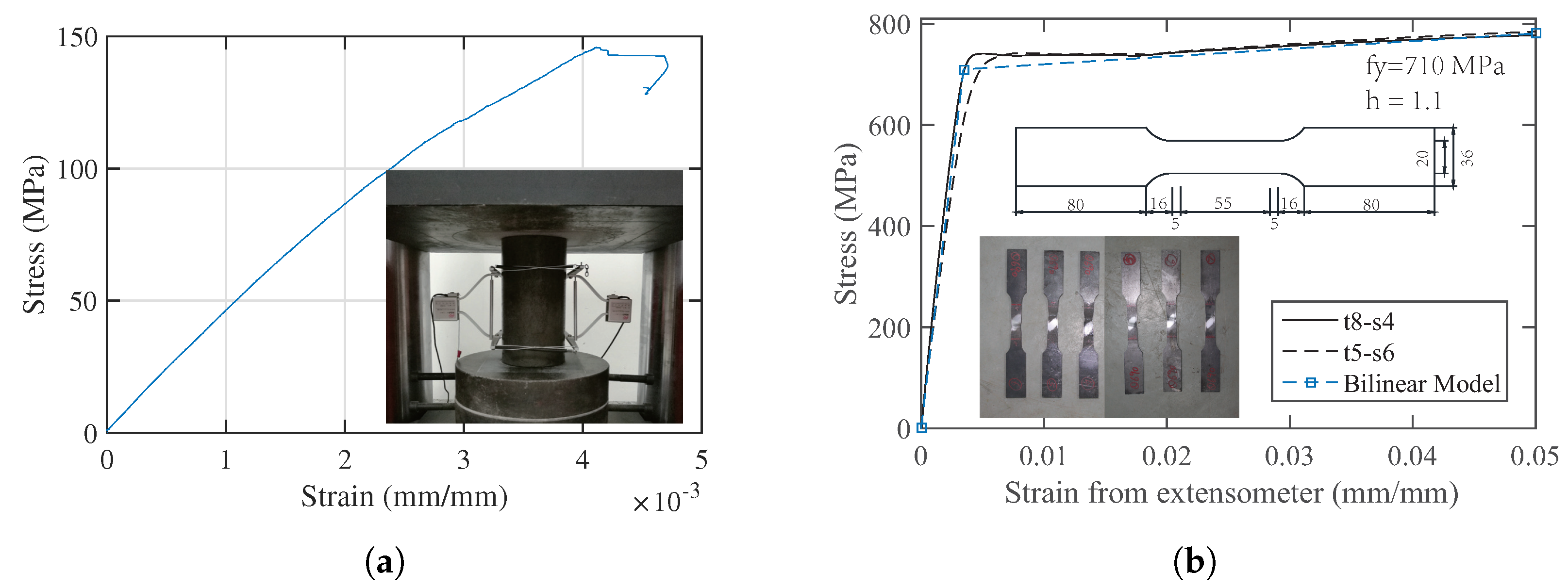
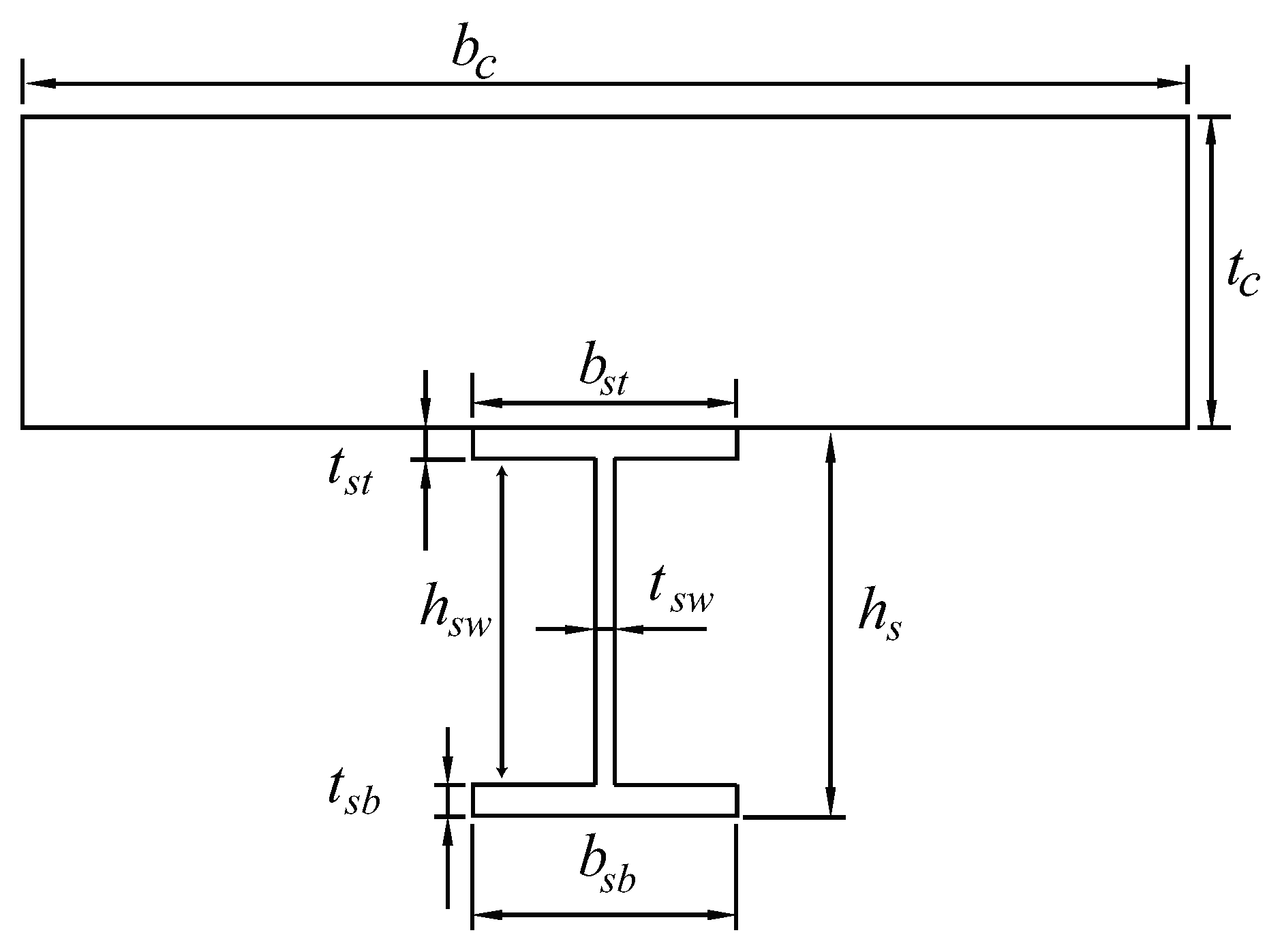

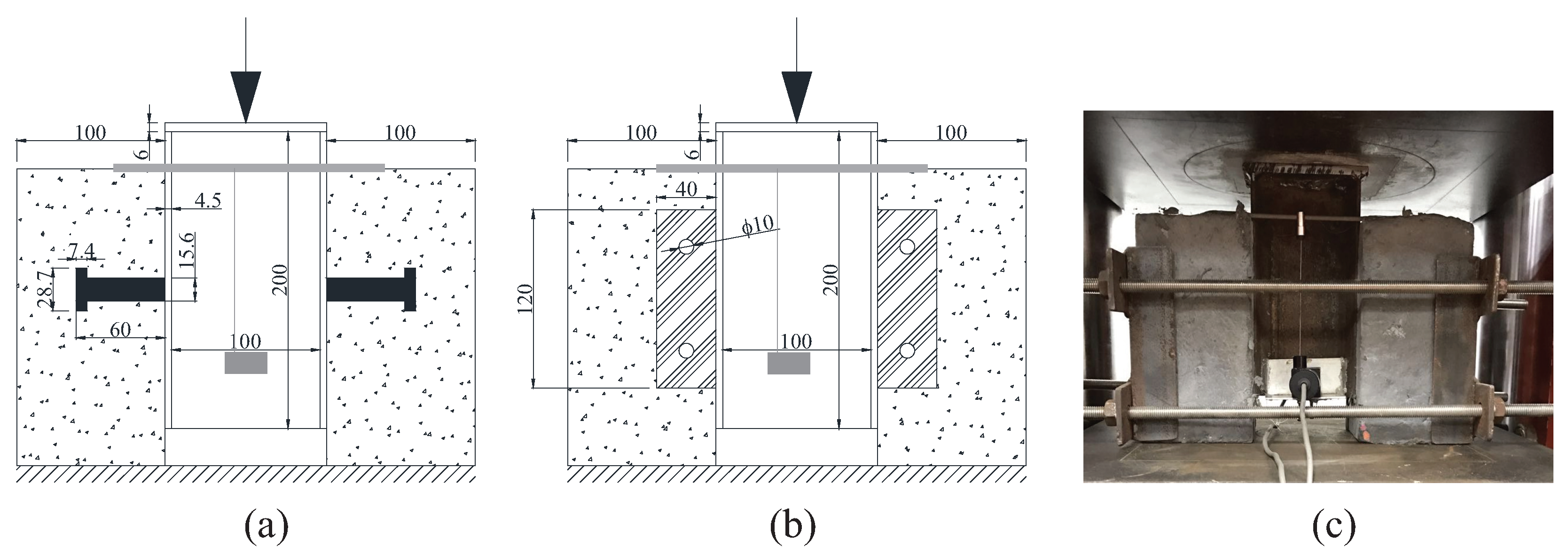

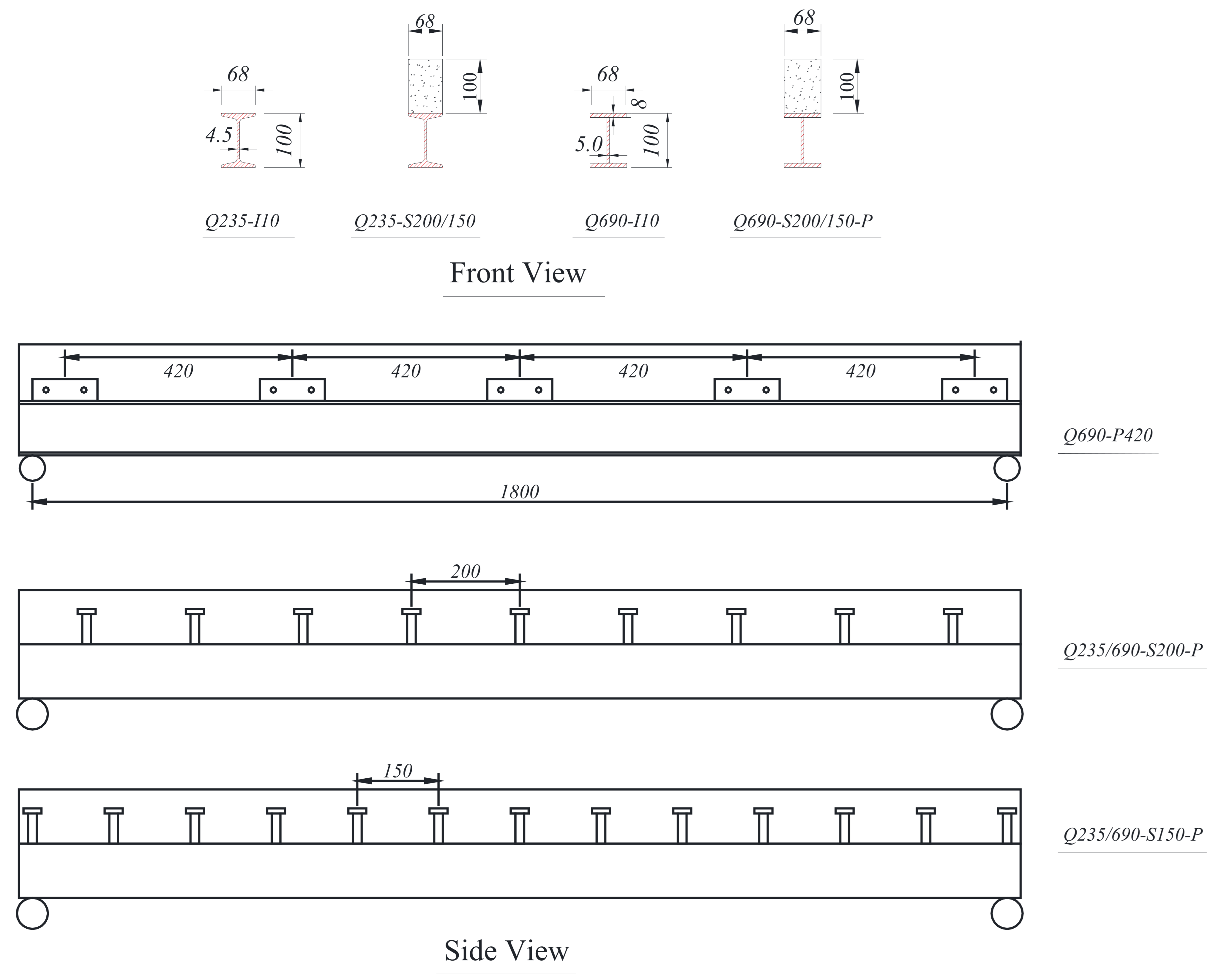
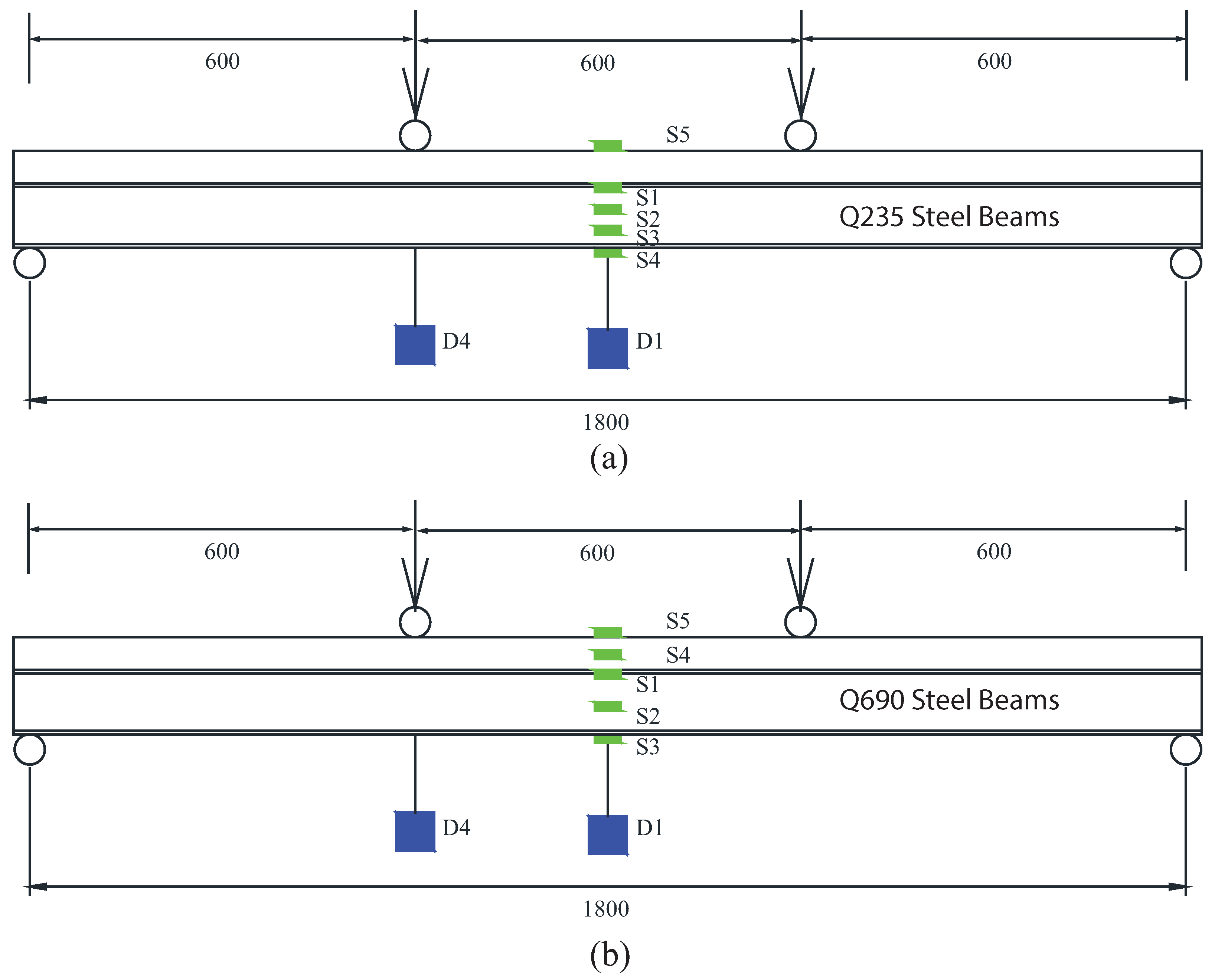
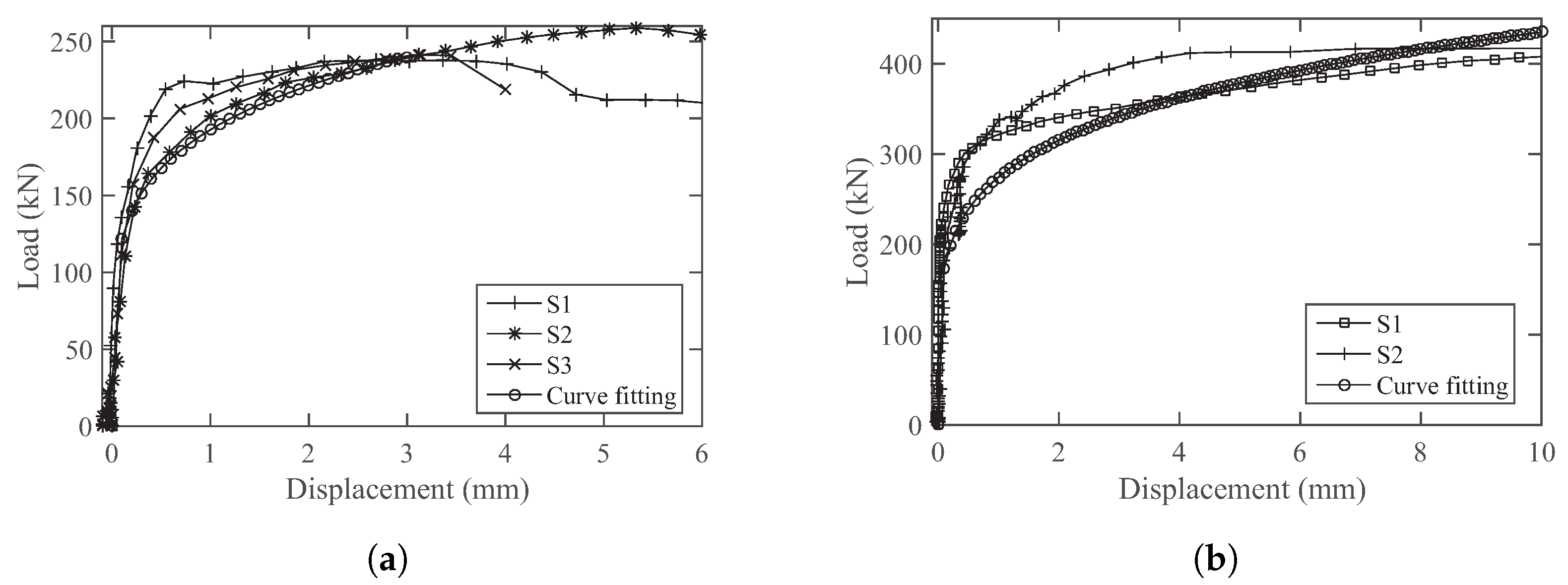

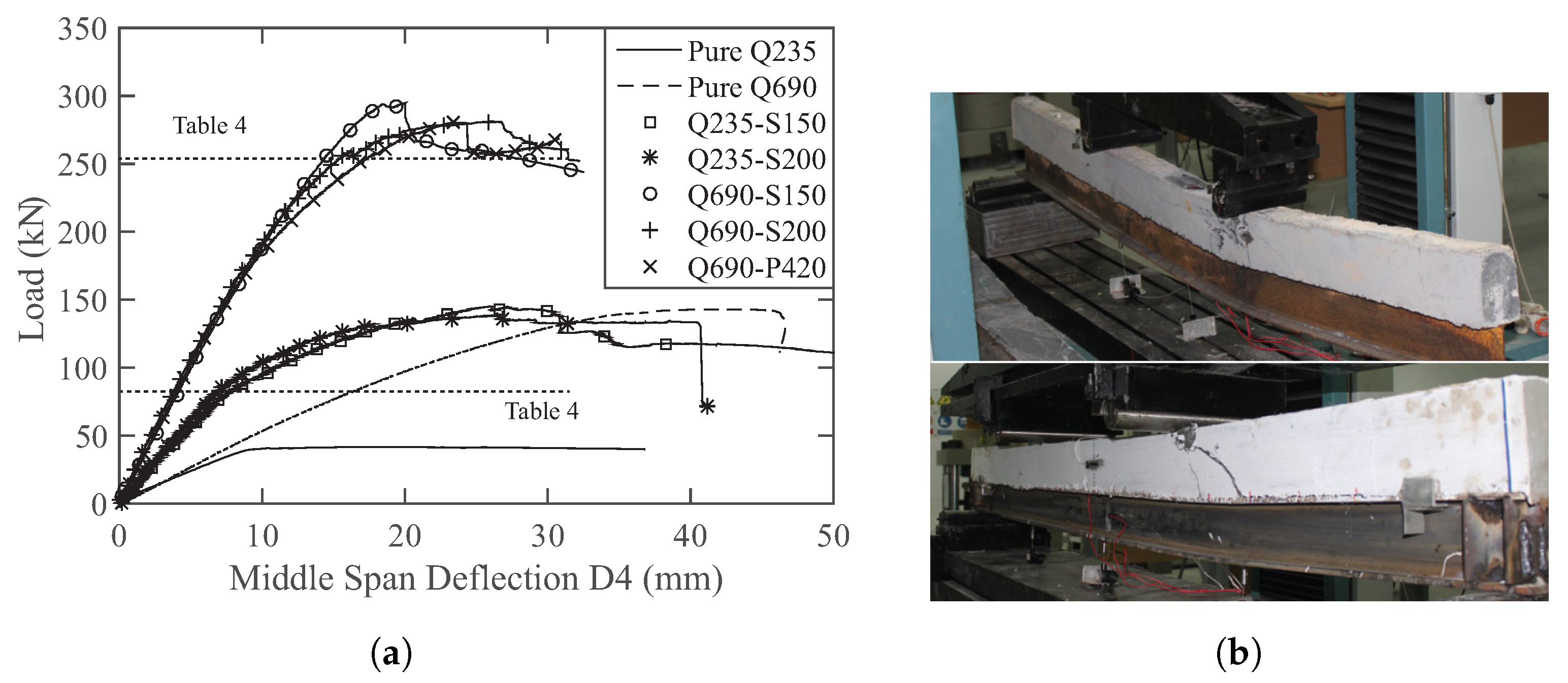
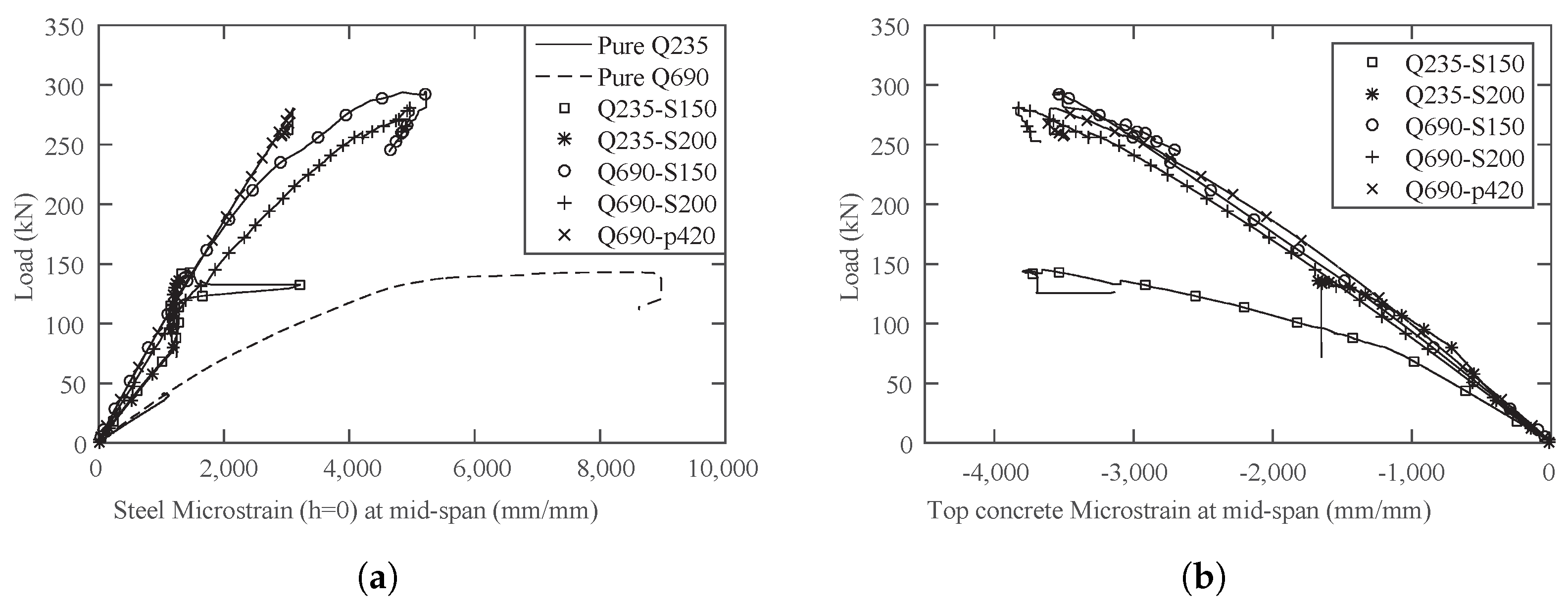


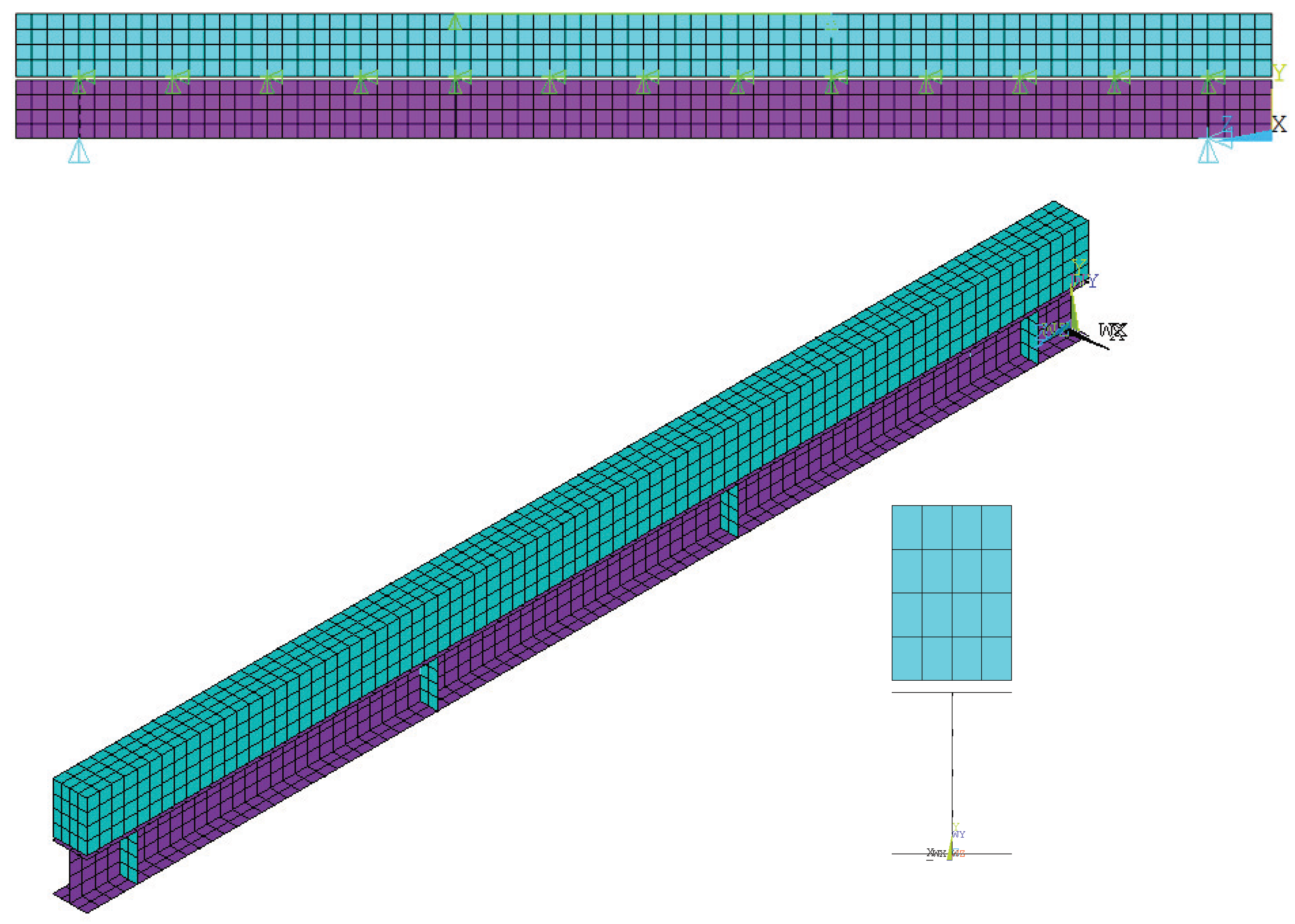

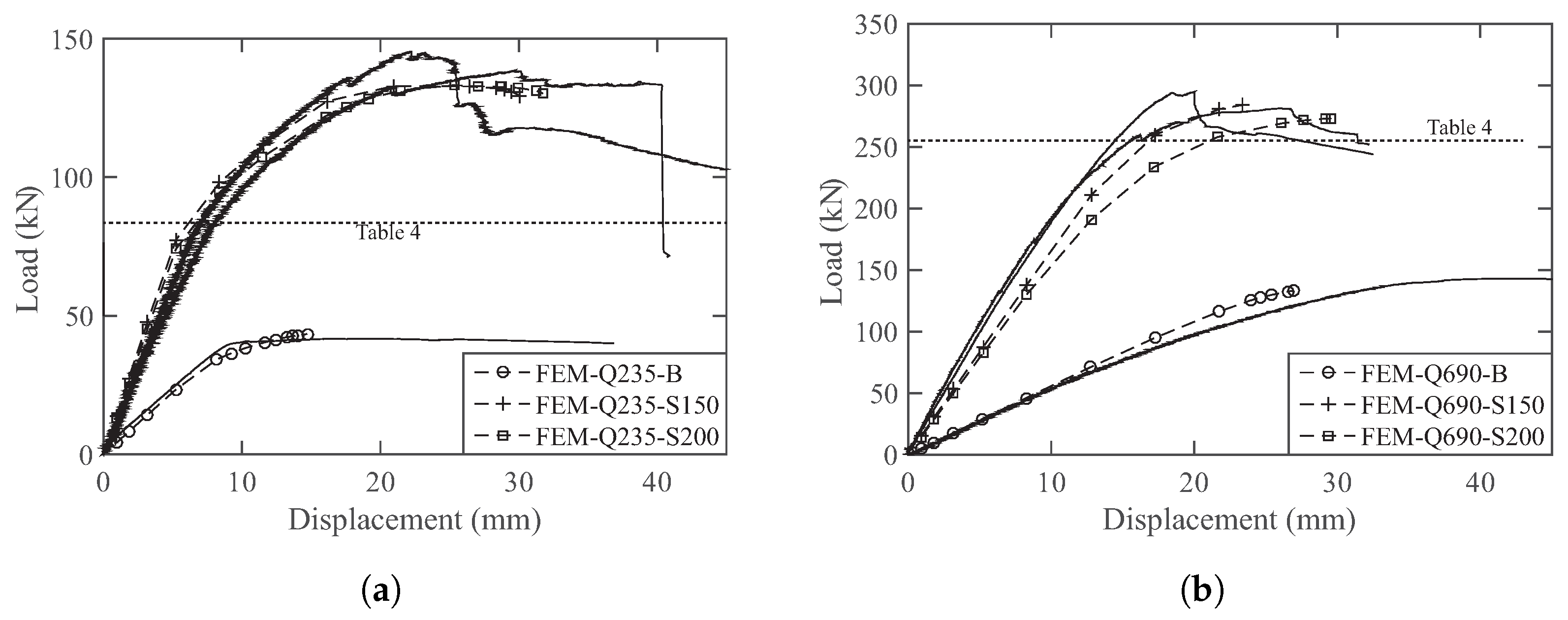
| Raw Material | Cement | Silica Fume | Ground Quartz | Fine Sand | Super-Plasticizer | Water | Fibers |
|---|---|---|---|---|---|---|---|
| Quantity kg/m3 | 712 | 231 | 211 | 1020 | 40 | 130 | 156 |
| ID | Height (mm) | (MPa) | (GPa) |
|---|---|---|---|
| 1 | 184.7 | 145.9 | 43.7 |
| 2 | 196.3 | 132.0 | 43.5 |
| 3 | 188.5 | 148.7 | 43.2 |
| 4 | 183.6 | 126.2 | 30.1 |
| 5 | 185.4 | 147.4 | 41.3 |
| Average | 140.0 | 41.9 | |
| STD | 10.2 | 2.3 |
| Desig. | Equation (7) | Equation (10) | Diff. | ||||||
|---|---|---|---|---|---|---|---|---|---|
| I10 | 100 | 68 | 4.5 | 7.6 | 68.75 | 101.44 | 3.85% | ||
| I20a | 200 | 100 | 7 | 11.4 | 85.51 | 202.90 | 1.28% | ||
| I32a | 320 | 130 | 9.5 | 15 | 101.03 | 324.64 | −0.44% | ||
| I40a | 400 | 142 | 10.5 | 16.5 | 103.72 | 405.80 | −1.51% | ||
| I50a | 500 | 158 | 12 | 20 | 115.04 | 507.25 | −1.82% | ||
| I63a | 630 | 176 | 13 | 22 | 118.46 | 639.13 | −2.82% |
| Category | Parameters | Unit | MPa | MPa |
|---|---|---|---|---|
| Steel section | mm | 68 | 68 | |
| mm | 8 | 7.6 | ||
| mm | 5 | 4.5 | ||
| mm | 100 | 100 | ||
| Concrete section | mm | 68 | 68 | |
| mm | 100 | 100 | ||
| Material properties | MPa | 690 | 235 | |
| MPa | −140 | −140 | ||
| GPa | 42 | 42 | ||
| GPa | 210 | 210 | ||
| Critical parameters | Equation (4) | mm | 101.45 | 297.87 |
| Equation (4) | mm | 73.26 | 7.97 | |
| Equation (7) | N · m | |||
| Design parameters | - | 0.928 | 8.53 | |
| - | 0.986 | 0.336 | ||
| Equation (11) | N · m | |||
| kN | 255.9 | 83.1 |
| Specimen ID | Steel Beam | Connector | ||
|---|---|---|---|---|
| Material | Profile | Type | Spacing | |
| Q235-S150 | Q235 | Hot roll I10 | Stud | 150 |
| Q235-S200 | Q235 | Hot roll I10 | Stud | 200 |
| Q690-S150-P | Q690 | Welded I10 | Stud | 150 |
| Q690-S200-P | Q690 | Welded I10 | Stud | 200 |
| Q690-P420 | Q690 | Welded I10 | Plate | 420 |
| Parameter | Value | Unit | Physical Meaning |
|---|---|---|---|
| 140 | MPa | Uniaxial compressive strength | |
| 10 | MPa | Uniaxial tensile strength | |
| 210 | MPa | Biaxial compressive strength | |
| 42 | GPa | Modulus of elasticity | |
| 0.0045 | – | Plastic strain at uniaxial compressive strength | |
| 0.01 | – | Ultimate effective plastic in compression | |
| 0.85 | – | Relative stress at onset of nonlinear hardening | |
| 0.1 | – | Residual compressive relative stress | |
| 0.01 | – | Plastic strain limit in tension | |
| 0.1 | – | Residual tensile relative stress |
Disclaimer/Publisher’s Note: The statements, opinions and data contained in all publications are solely those of the individual author(s) and contributor(s) and not of MDPI and/or the editor(s). MDPI and/or the editor(s) disclaim responsibility for any injury to people or property resulting from any ideas, methods, instructions or products referred to in the content. |
© 2024 by the author. Licensee MDPI, Basel, Switzerland. This article is an open access article distributed under the terms and conditions of the Creative Commons Attribution (CC BY) license (https://creativecommons.org/licenses/by/4.0/).
Share and Cite
Xia, J. Flexural Behavior of High-Strength Steel and Ultra-High-Performance Fiber-Reinforced Concrete Composite Beams. Buildings 2024, 14, 131. https://doi.org/10.3390/buildings14010131
Xia J. Flexural Behavior of High-Strength Steel and Ultra-High-Performance Fiber-Reinforced Concrete Composite Beams. Buildings. 2024; 14(1):131. https://doi.org/10.3390/buildings14010131
Chicago/Turabian StyleXia, Jun. 2024. "Flexural Behavior of High-Strength Steel and Ultra-High-Performance Fiber-Reinforced Concrete Composite Beams" Buildings 14, no. 1: 131. https://doi.org/10.3390/buildings14010131
APA StyleXia, J. (2024). Flexural Behavior of High-Strength Steel and Ultra-High-Performance Fiber-Reinforced Concrete Composite Beams. Buildings, 14(1), 131. https://doi.org/10.3390/buildings14010131








